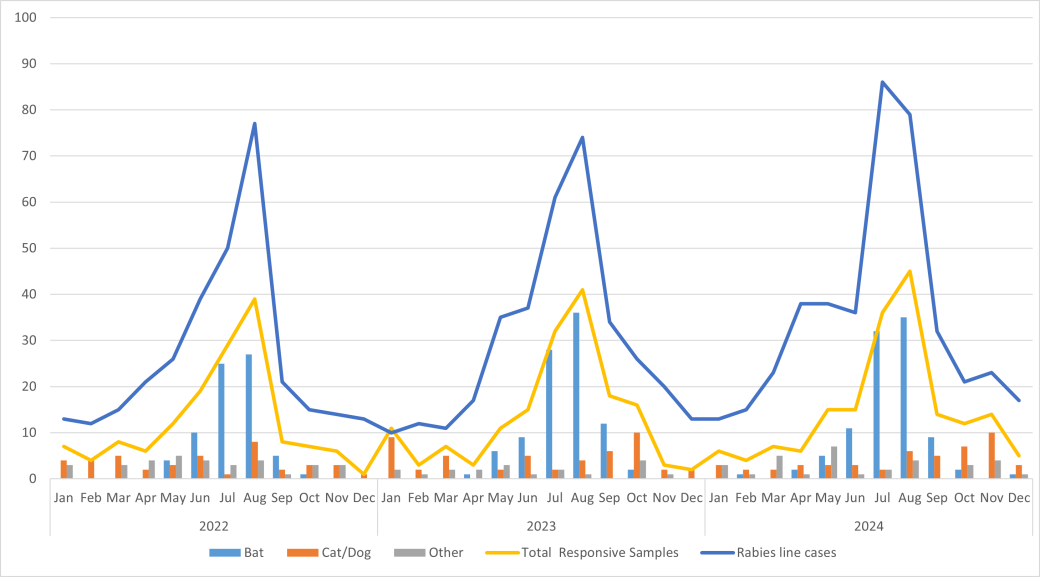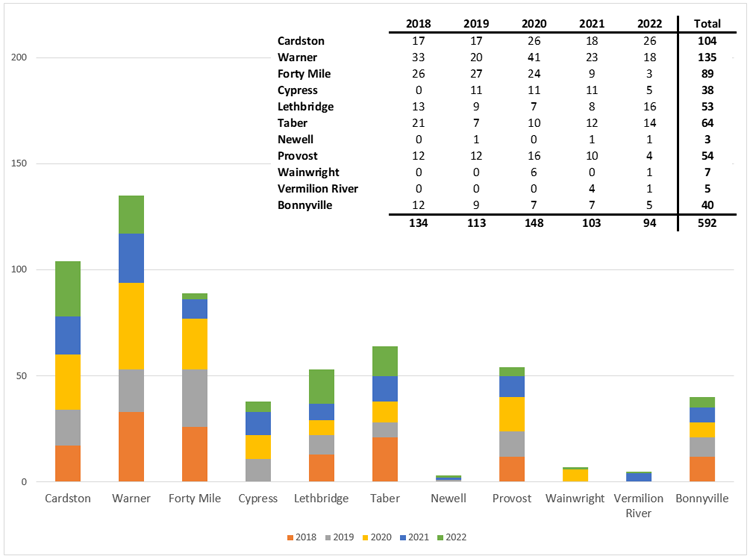Government mail service may be affected by the Canada Post labour disruption. Learn about how critical government mail will be handled.
Overview
The rabies testing and surveillance program is a partnership between the Alberta government, Canadian Food Inspection Agency, and several rural municipalities.
The program coordinates the testing of animal samples:
- in response to human or domestic animal exposure, and
- when a wild or domestic animal dies or is euthanized with signs suggestive of rabies
To find out what to do if a human or a domestic animal may have been exposed to rabies, if you see a bat in your home, or if you have observed potentially rabid wildlife, see If you suspect rabies.
Responsive testing
Alberta Rabies Program
Phone: 1-844-427-6847
Email: [email protected]
Agriculture and Irrigation operates the Rabies Program. Calls are primarily received from public health practitioners with Alberta Health Services and Indigenous Services Canada, veterinary clinics, wildlife personnel and members of the public.
Calls to the Rabies Line during regular business hours are answered by Registered Veterinary Technologists who work with Alberta’s Public Health Veterinarian. Together they provide information and advice on rabies in Alberta, most commonly with respect to potential human or domestic animal exposures.
Testing
Agriculture and Irrigation staff coordinate sample submission when it is necessary to test animals for rabies. Testing may be undertaken when the results are necessary to inform the management of an exposed human or domestic animal, or when a wild or domestic animal displays clinical signs compatible with rabies. This testing data provides a source of passive surveillance for the presence of rabies in Alberta.
Depending on location and staff availability, rabies program staff may collect and ship animal specimens or may request the assistance of a local veterinary clinic. Veterinary clinics are provided with submission forms as well as packaging and shipping information and are compensated for their assistance.
Rabies samples are tested at the Canadian Food Inspection Agency (CFIA) National Center for Animal Diseases outside Lethbridge, Alberta.
Surveillance in striped skunks
Presently, only bat rabies virus variants are endemic in Alberta. However, skunk rabies variants are present in Saskatchewan and Montana. For this reason, a skunk trapping and testing program was maintained in Alberta from 1970 through 2022, directed by the Central Rabies Control Committee. Each year, rural municipalities along the eastern and southern borders of the province worked with field technicians to sample skunk populations in their jurisdiction. Trapped skunks were delivered to Agriculture and Irrigation for preparation and submission to the CFIA laboratory.
Over time, the distribution of skunk rabies in Saskatchewan and Montana has changed and there have been no detections within 200 km of the Alberta border in at least 10 years. Therefore, active surveillance in striped skunks through random trapping was suspended effective in 2023. The program now focuses on rabies testing of skunks that have been observed with neurological or other signs suggestive of rabies. This approach, termed passive surveillance, is a more efficient means of detecting rare events as compared to a random sample of mostly healthy animals. Relying on passive surveillance is appropriate given the current level of risk. Rabies detections in Saskatchewan and Montana continue to be monitored to detect changes in risk.
If a positive skunk is found, which last occurred in 1994, steps are taken to reduce the skunk population in the immediate area and thereby reduce the potential for the virus to spread. Animals removed from the population are tested for rabies virus and the response area is expanded if additional cases are detected.
Table 1. Annual rabies positives in Alberta, 1952 to 2024

Data table of confirmed rabies detections in animals in Alberta 1927 to 2024
Table notes:
- Wildlife includes primarily coyote and fox.
- Terrestrial species positives since 2000:
- 2001, 2006, 2010 and 2018 one case each in cats (confirmed / presumed bat rabies virus variants)
- 2013 one puppy imported from Nunavut while incubating rabies (arctic fox virus variant)
- Alberta’s last case of rabies in a human was in 2007 (bat rabies virus variant)
Table 2. Alberta responsive samples for rabies testing 2022 to 2024
| 2024 | 2023 | 2022 | ||||
|---|---|---|---|---|---|---|
| Species | Total samples tested | Human exposure1 samples | Non-human2 exposure | Total positive | Total samples (human exposure/ non-human exposure/ total positive) | |
| Bats | 98 | 28 | 70 | 5 | 94 (35/59/5) | 72 (22/50/3) |
| Domestic cat | 27 | 23 | 4 | 0 | 25 (20/5/0) | 22 (22/0/0) |
| Domestic dog | 22 | 21 | 1 | 0 | 24 (22/2/0) | 19 (14/5/0) |
| Livestock | 8 | 2 | 6 | 0 | 4 (2/2/0) | 7 (4/3/0) |
| Coyote | 9 | 7 | 2 | 0 | 6 (4/2/0) | 5 (3/2/0) |
| Fox | 2 | 1 | 1 | 0 | 0 (0/0/0) | 1 (1/0/0) |
| Raccoon | 7 | 2 | 5 | 0 | 1 (0/1/0) | 1 (0/1/0) |
| Skunk | 3 | 1 | 2 | 0 | 5 (0/5/0) | 15 (0/15/0) |
| Other3 | 3 | 1 | 2 | 0 | 3 (3/0/0) | 5 (4/1/0) |
| Total responsive submissions | 179 | 87 | 92 | 5 | 162 (86/76/5) | 147 (70/77/3) |
Positive samples from 2024
- Aug 7: big brown bat – found in a residential basement and died the following day, possible contact with people
- Aug 14: big brown bat – bit a person in a home
- Sep 5: big brown bat – found on the ground fighting with another bat, known dog contact
- Sept 12: big brown bat – found grounded on residential doorstep, possible cat contact
- Sept 24: silver haired bat – found grounded in a residential yard, possible dog contact
Positive samples from 2023
- May 14: big brown bat – found grounded in residential garage, possible dog and cat contact
- Aug 7: big brown bat – found grounded in residential yard and acting aggressively, possible dog contact
- Aug 19: little brown bat – found inside a home with signs of weakness/paralysis, observed contact with dog
- Sept 2: hoary bat – found dead on residential driveway, possible cat contact
- Sept 6: silver-haired bat – found live on residential deck, possible dog contact
Positive samples from 2022
- July 31: little brown bat – attacked/bit person outdoors
- July 31: little brown bat – grounded bat on front stoop, possible cat contact
- October 2: silver haired bat – bat unable to fly, submitted to permitted rehabilitation facility, displayed neurologic abnormalities (no human or domestic animal exposure)
Table 3. Rabies line cases and samples submitted, 2022 to 2024*

*Number of cases responded to by rabies line personnel, and number and type of rabies samples tested in 2022 to 2024, by month. One ‘case’ generally involves multiple email and phone contacts and may involve multiple stakeholders such as a member of the public, public health personnel and a veterinary clinic.
Table 4. Number of skunk surveillance samples by county, 2018 to 2022
